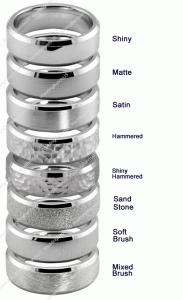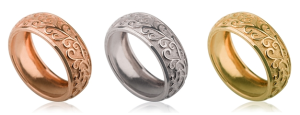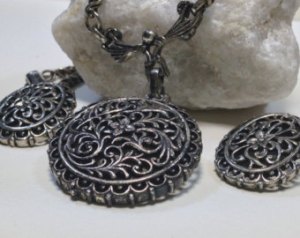Metal Finishes on Jewelry
Have you ever wondered what some of the jewelry terms really meant when reading a description of a bracelet or necklace you really liked? For example, what is “rhodium-plated” and what does “oxidized” mean? This article explains various aspects of jewelry metals, as well as how metals are finished and beautified before a piece is ready for sale.
All jewelry has some form of finish. Even as a designer begins to express his skill and creativity in the formation of a piece of jewelry, finish always plays a major role. The choices are many–brushing, hammering, diamond cutting, microblasting, and burnishing, to name just a few. Finish adds the final touch to every jewelry creation.
Manufacturers have managed to develop a wide array of techniques to improve upon the appearance and salability of their products. Sometimes the goal is a harmonious understated elegance; at other times, it is a bold statement of contrasts. The range of styles, motifs, and finishes is limited only by the creativity of the designer and the demand of the marketplace.
So have you ever wondered how jewelry manufacturers get that really bright finish on your ring or bracelet? A mirror-like finish can be applied by a number of techniques, some of which have been around for decades, others for centuries. Let’s discuss finish.
Types of Finishes on Metal
 When dealing with jewelry, the term finish has more than one meaning. Firstly, it may refer to the overall level of workmanship in the piece. Jewelry should not, for example, have any sharp edges, scratches marring its surface, incomplete detail work, or indistinct finish boundaries (unless done for effect). Such imperfections detract from the beauty, elegance, and feel of jewelry.
When dealing with jewelry, the term finish has more than one meaning. Firstly, it may refer to the overall level of workmanship in the piece. Jewelry should not, for example, have any sharp edges, scratches marring its surface, incomplete detail work, or indistinct finish boundaries (unless done for effect). Such imperfections detract from the beauty, elegance, and feel of jewelry.
Secondly, finish may refer to the style of surface texturing on a piece of jewelry. A surface may appear semi-bright to mirror-like, or it may have some form of brushing, micro-blasting, or other texturing to add style or contrast.
Polishing
There are different methods of creating reflective surfaces on precious metals. One is polishing with specialized compounds, called rouges. Rouges vary in coarseness based on the size of the abrasive particles contained in them. The appropriate rouges are applied to specialized wheels and cones at different stages in the finishing process. There are different rouges for gold, silver, and platinum.
Buffing
Polishing in the truest sense is an operation that removes most of the larger, deeper surface irregularities and paves the way for the next step, called buffing. Buffing removes very little precious metal from the piece and uses rouges containing extremely fine abrasives. Buffing may produce a highly reflective mirror-like finish or even a duller, semi-bright finish, depending on the manufacturer’s intent.
Tumbling or Mechanical Burnishing
Another method of creating a reflective surface is to tumble pieces in specialized media containing some form of lubricant, such as water and detergent. The tumbler itself is an electronic agitator that shakes the pieces in a circular motion. The tumbling media may range from metal balls to walnut shells that continually rub against and flatten the surface of the precious metal, increasing its luster. The longer the pieces are left to tumble, the brighter their surfaces will be. Tumbling is considered a form of mechanical burnishing.
Hand Burnishing
While mechanical burnishing is an inexpensive way to finish jewelry, hand burnishing is not. Hand burnishing produces a highly reflective finish by using a variety of specialized tools to compress and flatten the surface of the precious metal. A lubricant is always required when burnishing.
Each stroke, which involves a tool pressing against the surface of the piece, creates a bright streak. The trick is to layer or overlap each streak to form a continuous bright surface over the desired area. If an even finer, longer-lasting surface is needed, the piece can be burnished again perpendicular to the original stroke. While time consuming and labor intensive, hand burnishing does not remove any of the precious metal from the jewelry and can produce a very striking effect.
Any of those various finishing possibilities, while applied at the end of the crafting of a piece of jewelry, have to be thought out in advance, which is why fine jewelry, in a real sense, begins and ends with finishing.


You must be logged in to post a comment.